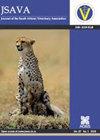2001-2021年南非林波波省勒法莱市恶性卡他热的实验室纵向监测
IF 0.9
4区 农林科学
Q3 VETERINARY SCIENCES
引用次数: 0
摘要
本文章由计算机程序翻译,如有差异,请以英文原文为准。
Laboratory-based longitudinal surveillance of malignant catarrhal fever in Lephalale municipality in Limpopo province, South Africa: 2001–2021
2021. Laboratory registry data for 385 samples were analysed. The data included the date of sampling, sample type, animal species, location and the MCF test result (PCR and/or histopathology). Altogether, 57.4% ( n = 221) of the samples were positive with a frequency of detection of 86.4% ( n = 191) and 13.6% ( n = 30) for samples tested using PCR and histopathology respectively. Of the PCR-positive samples, 99.5% were positive for AIHV-1 and 0.5% for OvHV-2. AIHV-1 infection was recorded during various seasons throughout the two decades while OvHV-2 was only reported in spring of the year 2010. Moreover, AIHV-1 was detected with a high frequency in blood (66.5%), brain (22.5%) and organ (10.5%) samples from different areas within the municipality, while OvHV-2 was only detected in blood (0.5%) samples. A retrospective study such as this provides useful information on the occurrence of MCF in the Lephalale municipality. Data from this study suggests that MCF caused by AIHV-1 is regularly diagnosed in the Lephalale municipality with concomitant adverse effects on the cattle population. Therefore, there is a need to formulate policies and strategies for disease control and enhance farmer education on the epidemiology of the disease within the study area to improve animal health and production.
求助全文
通过发布文献求助,成功后即可免费获取论文全文。
去求助
来源期刊

Journal of the South African Veterinary Association
VETERINARY SCIENCES-
CiteScore
1.50
自引率
0.00%
发文量
23
审稿时长
22 weeks
期刊介绍:
The Journal of the South African Veterinary Association is a contemporary multi-disciplinary scientific mouthpiece for Veterinary Science in South Africa and abroad. It provides veterinarians in South Africa and elsewhere in the world with current scientific information across the full spectrum of veterinary science. Its content therefore includes reviews on various topics, clinical and non-clinical articles, research articles and short communications as well as case reports and letters.
 求助内容:
求助内容: 应助结果提醒方式:
应助结果提醒方式:


